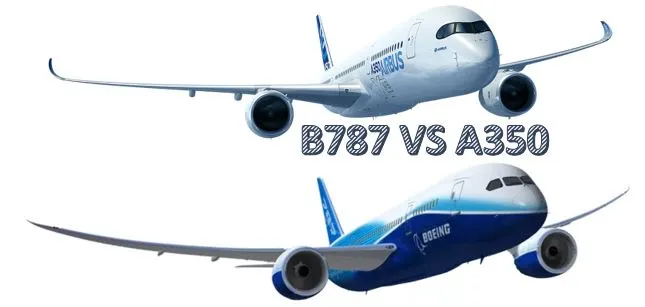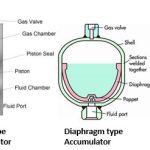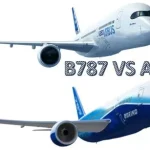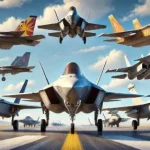The Boeing 787 Dreamliner and the Airbus A350 are two of the coolest planes flying in the skies today. Both are packed with cutting-edge technology and designed to make long-haul flights as smooth and comfortable as possible. But if you’re wondering which one’s better, let’s break it down from both a passenger’s perspective and an engineering geek’s point of view. Ready? Let’s dive in!
Passenger Experience
Cabin Comfort
- Boeing 787: The 787 is all about comfort. It has these big, fancy windows you can dim electronically—no more fiddling with plastic shades! The cabin is pressurized to feel like you’re at 6,000 feet instead of 8,000, so you’re less likely to feel tired after a long flight. Plus, the air is more humid, which means your skin won’t feel as dry.
- Airbus A350: Not to be outdone, the A350 also keeps the cabin pressure at a comfy 6,000 feet and bumps up the humidity. The windows aren’t dimmable like the 787’s, but they’re huge, and the LED mood lighting is super customizable. Oh, and thanks to a slightly wider fuselage, the seats and aisles feel a tad roomier.
Winner: Tough call! The A350’s extra space might win over economy travelers, but those dimmable windows on the 787 are hard to beat.
Noise Levels
- Boeing 787: This plane is really quiet, thanks to its advanced engines and clever insulation.
- Airbus A350: The A350 is also whisper-quiet, using similar tech to keep noise levels low.
Winner: The A350 might be a smidge quieter, but honestly, both are so quiet you’ll forget you’re flying.
Inflight Entertainment and Connectivity
- Boeing 787: The inflight entertainment here is top-notch, with HD screens and Wi-Fi (though it depends on the airline).
- Airbus A350: The A350 doesn’t hold back either. It’s got wide screens, great viewing angles, and high-speed Wi-Fi to keep you connected.
Winner: It’s a tie! Both planes deliver fantastic entertainment options—it just depends on the airline’s setup.
Engineering Marvels
Size Comparison
Here’s a quick side-by-side look at the dimensions and passenger capacities of the two aircraft:
| Feature | Boeing 787-8 | Boeing 787-9 | Boeing 787-10 | Airbus A350-900 | Airbus A350-1000 |
|---|---|---|---|---|---|
| Length (feet) | 186 | 206 | 224 | 219 | 242 |
| Passenger Capacity | ~248 | ~296 | ~336 | ~440 max | ~480 max |
| Wingspan (feet) | 197 | 197 | 197 | 212 | 212 |
| Maximum Range (Nmi) | ~7,305 | ~7,565 | ~6,330 | ~8,500 | ~8,900 |
Winner: If you’re looking for size and capacity, the A350 takes the lead. However, the 787 is more compact and versatile for routes with lower passenger demand.
Materials and Design
- Boeing 787: This beauty is made of 50% composite materials, which makes it lighter and more fuel-efficient. Its wings are designed to flex in flight, making turbulence less noticeable.
- Airbus A350: The A350 steps it up with 53% composite materials and a sleek design that includes those signature curved wings with sharklets. It’s all about cutting drag and boosting efficiency.
Winner: The A350 takes this one with slightly more composite content and those aerodynamic wings.
Engines and Efficiency
- Boeing 787: The Dreamliner’s engines (either General Electric GEnx or Rolls-Royce Trent 1000) are super fuel-efficient, burning 20% less fuel than older jets.
- Airbus A350: The A350’s Rolls-Royce Trent XWB engines are equally impressive, and they’re optimized for even longer flights. Overall, the A350 is reported to achieve up to 25% greater fuel efficiency compared to previous-generation aircraft, slightly edging out the 787 in ultra-long-haul efficiency metrics.
Winner: The A350’s fuel efficiency on longer routes gives it a slight edge, but both planes are incredibly efficient.
Flight Deck Tech
- Boeing 787: Pilots love the 787’s glass cockpit with big, multifunctional displays. It’s user-friendly and packed with tech to make flying easier.
- Airbus A350: The A350’s cockpit is just as advanced, with even larger screens and Airbus’s signature sidestick controls instead of the traditional yoke.
Winner: This one’s subjective—some pilots prefer Airbus’s sidestick, while others stick with Boeing’s yoke. Either way, both cockpits are cutting-edge.
Maintenance and Reliability
- Boeing 787: The Dreamliner uses predictive analytics to flag potential issues before they become problems, reducing downtime.
- Airbus A350: The A350 does this too but benefits from a newer design, which could mean slightly lower maintenance costs in the long run.
Winner: The A350’s newer design gives it a slight edge here, but the 787 is no slouch.
So, Which Plane Is Better?
If you’re a passenger, it’s almost a tie. The A350’s extra space might make long-haul flights a bit more pleasant, but the 787’s innovative windows are a game-changer. From an engineering perspective, the A350 has a slight edge in efficiency and maintainability, but the 787 still deserves major props for pioneering the use of composite materials.
In the end, it really depends on what you value most—comfort, innovation, or efficiency. Either way, both planes are incredible feats of engineering, and you’re in for a great flight no matter which one you choose.



